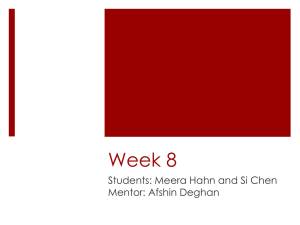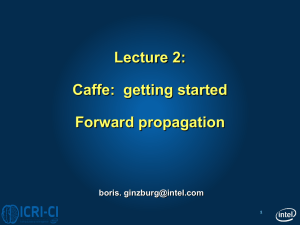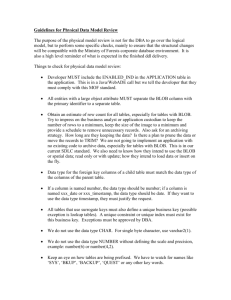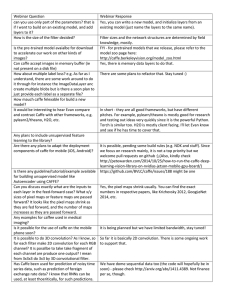CAFFE Tutorial Slides
advertisement
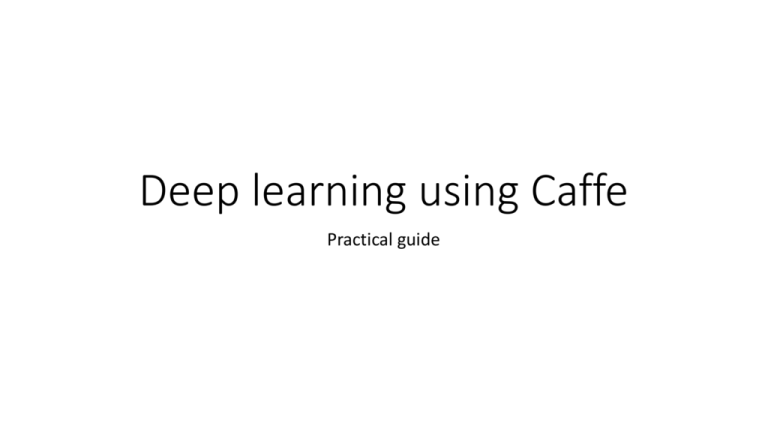
Deep learning using Caffe
Practical guide
Open source deep learning packages
• Caffe
• C++/CUDA based.
• MATLAB/python interface.
• Theano-based
• Compiled on the spot.
• Python interface.
• Torch
• Lua interface
• MatConvNet
• User friendly, matlab interface
• TensorFlow
• New and promising?
Use Caffe at Wisdom
• Connect to mcluster01
ssh mcluster01
• Start a session on one of the GPU nodes
qsh -q gpu.q
• Set environment variables
setenv LD_LIBRARY_PATH /usr/local/cuda/lib64:/usr/local/lib
• Caffe location
/usr/wisdom/caffe-cpu
• For Python interface, set environment variables
setenv PATH /usr/wisdom/python/bin:$PATH
setenv PYTHONPATH /usr/wisdom/python
Download Caffe
+ copy Makefile.config
+ make all
+ make matcaffe
+ make pycaffe
Caffe - Storing Data In Memory
Width
C x H xW
Channel
Height
Caffe - Storing Data In Memory
Blob size: N x
C x H xW
• Caffe stores and communicates data using
blobs.
• Blobs provide a unified memory interface
holding data
• e.g., batches of images, model
parameters, and derivatives for
optimization.
Layer
• The layer is the fundamental unit
of computation.
• A layer takes input
through bottom connections and
makes output
through top connections
• Each layer type defines three
computations: setup, forward,
and backward.
top blob
ip
ip (InnerProduct)
bias
weights
data
bottom blob
Layer Forward
• The forward pass goes
from bottom to top
• During forward pass Caffe
composes the
computation of each layer
to compute the “function”
represented by the model.
top blob
ip
ip (InnerProduct)
bias
weights
data
bottom blob
Layer Backward
• The backward pass
performs back-propagation
• Given the gradient w.r.t. the
top output Caffe computes
the gradient w.r.t. to the
input and sends to the
bottom.
• A layer with parameters
computes the gradient w.r.t.
to its parameters and stores
it internally.
top blob
ip
ip (InnerProduct)
bias
weights
data
bottom blob
Net
• A network is a set of layers
and their connections
• Most of the time linear graph
• Could be any directed acyclic graph (DAG).
• end-to-end machine learning: needs to
start from data and end in loss.
LogReg ↑
LeNet →
Krizhevsky 2012 →
ImageNet
Simple Example – Linear regression
• Suppose there are n data points:
• The function that describes x and y is :
• The goal is to find the equation of the straight line
which would provide a "best" fit for the data points.
• Here the "best" will be understood as in the least-squares
approach: a line that minimizes the sum of squared residuals of
the linear regression model.
• In other words, w and b that solve the following minimization
problem:
name: "LinearReg"
layer {
name: “input"
type: "Data"
top: "data"
top: “value"
data_param {
source: "input_leveldb"
batch_size: 64
}
}
layer {
name: "ip"
type: "InnerProduct"
bottom: "data"
top: "ip"
inner_product_param { num_output: 1 }
}
layer {
name: "loss"
type: "EuclideanLoss"
bottom: "ip"
bottom: “value"
top: "loss"
}
Simple Example – Linear regression
Simple Example – Linear regression
Gradient descent
• Gradient descent is a first-order optimization algorithm.
• To find a local minimum of a function using gradient descent, one takes steps proportional to
the negative of the gradient (or of the approximate gradient) of the function at the current
point.
• One starts with a guess w0 for a local minimum of F, and considers the sequence w0, w1, w2,…
such that
If function F is defined and differentiable in a neighborhood of a point wt,
then for small enough step size eta we get that:
so hopefully the sequence wt converges to the desired local minimum.
• Note that the value of the step size eta is allowed to change at every iteration.
Learning using gradient descent
• Loss function we are minimizing
• Gradient descent
• Problem – for large N, a single step is very expensive.
Stochastic gradient descent
• Loss function we are minimizing
• Gradient descent
• Problem – for large N, a single step is very expensive.
• Solution – Stochastic gradient descent. At each iteration select random data
points
with batch size B, then
• As B grows, we get a better approximation of the real gradient but at a
higher computational cost.
Simple Example – Linear regression
Use gradient descent
Simple Example – Linear regression
Simple Example – Linear regression
Simple Example – Linear regression
Caffe knows that data layers do not
require back propagation and will not
compute the derivatives
Layers Overview
• Data Layers
Data can come from efficient databases (LevelDB or LMDB), directly from memory, or, when
efficiency is not critical, from files on disk in HDF5 or common image formats.
Has common input preprocessing (mean subtraction, scaling, random cropping, and mirroring)
• Common Layers
Various commonly used layers, such as: Inner Product, Reshape, Concatenation, Softmax, …
• Vision Layers
Vision layers usually take images as input and produce other images as output. Most of the vision
layers work by applying a particular operation to some region of the input to produce a
corresponding region of the output. In contrast, other layers (with few exceptions) ignore the spatial
structure of the input, effectively treating it as “one big vector” with dimension CxHxW.
• Neuron Layers
Neuron layers are element-wise operators, taking one bottom blob and producing one top blob of
the same size.
• Loss Layers
Loss drives learning by comparing an output to a target and assigning cost to minimize. The loss is
computed by the forward pass.
Data layers:
• Caffe supports leveldb, lmdb, HDF5 and images inputs.
• HDF5
• very flexible and easy to use.
• Problem – loads all the data into memory at once (problematic on large datasets).
• Leveldb & LMDB
• works sequentially.
• Less flexible (Caffe-wise).
• Much faster.
• Images
• takes a text file with image paths and labels (imagenet).
Data Layer – leveldb&LMDB
layer {
name: "mnist"
type: "Data"
top: "data"
top: "label"
include {
phase: TRAIN
}
transform_param {
scale: 0.00390625
}
data_param {
source: "examples/mnist/mnist_train_lmdb"
batch_size: 64
backend: LMDB
}
}
• Name – for reusing net params (finetunning)
• Bottom – on every layer except data
• Top – for leveldb&LMBD always 2 top, data blob and label
blob. Label is integer and of size Nx1x1x1.
• Phases – select when to use layer, default == both.
• For TEST phase define another layer with the same name
• Transform_param – do simple preprocessing.
• Data_param – tell caffe where (and what type) the data is.
• Batch_size – how many examples per batch. Small
batch_size is faster, but more oscillatory.
• Backend – leveldb / LMDB
Common Layer - Inner product layer
layer {
name: "fc8"
type: "InnerProduct"
# learning rate and decay multipliers for the weights
param { lr_mult: 1 decay_mult: 1 }
# learning rate and decay multipliers for the biases
param { lr_mult: 2 decay_mult: 0 }
inner_product_param {
num_output: 1000
weight_filler {
type: "gaussian"
std: 0.01
}
bias_filler {
type: "constant"
value: 0
}
}
bottom: "fc7"
top: "fc8"
}
• Linear function
• In =
, Bottom blob is of size (N,C,H,W)
• Out is a layer parameter (num_output). Top blob is
(N,out,1,1).
• Number of parameters:
• Param allows you to change specific layer learning rate,
and separates weights and biases.
• During Net Finetunning: fixed layer – lr_mult: 0
• Can run on a single axis, see documentation.
Vision Layer - Convolutional Layer
• The Convolution layer convolves the input image with a set of learnable
filters, each producing one feature map in the output.
• Input size (H,W)
• Kernel size (K,K)
• Output size (H-K+1,W-K+1)
Vision Layer - Convolutional Layer
• Convolution with zero-padding of P pixels
0
0
0
0
0
0
0
0
1
1
1
0
0
0
2
2
3
1
1
0
0
1
1
1
0
0
1
4
3
4
1
0
0
0
1
1
1
0
2
2
4
3
3
0
0
1
1
1
0
0
1
2
3
4
1
0
0
1
1
0
0
0
1
2
3
1
1
0
0
0
0
0
0
0
• Convolution with zero-padding of P pixels and S pixels stride
Vision Layer - Convolutional Layer
• Input size (C,H,W)
• Kernel size (C,K,K)
• Output size (H-K+1,W-K+1)
Vision Layer - Convolutional Layer
• Input size (C,H,W)
• D Kernels of size (C,K,K)
• Output size (D,H-K+1,W-K+1)
Vision Layer - Convolutional Layer
• Input size (C,H,W)
• D Kernels of size (C,K,K)
• Output size (D,H-K+1,W-K+1)
D
Vision Layer - Convolutional Layer
• Given bottom of size (N,C,H,W)
• Convolves each (C,H,W) image
• Using D kernels of size (C,K,K)
• Returns top of size
Assuming P pixels padding and stride of S pixels
• Number of parameters =
Vision Layer - Convolutional layer
layer {
name: "conv1"
type: "Convolution"
bottom: "data"
top: "conv1"
param { lr_mult: 1 }
param { lr_mult: 2 }
convolution_param {
num_output: 20
kernel_size: 5
pad: 2
stride: 1
weight_filler { type: "xavier“ }
bias_filler { type: "constant“ }
}
}
• Kernel_size – doesn’t have to be symmetric.
• pad – specifies the number of pixels to
(implicitly) add to each side of the input
• stride – step size in pixels between each filter
application, reduce output size by a factor.
• weight_filler – random weight initialization.
Break symmetry. “Xavier” picks std according to
blob size. See “Understanding the difficulty of training deep
feedforward neural networks” Glorot and Bengio 2010.
• Performing a convolution with kernel size
(C,H,W) is equivalent to performing inner
product.
Vision Layer – Deconvolution (Convolution Transpose)
layer {
name: "upscore2“
type: "Deconvolution“
bottom: "score59“
top: "upscore2“
param {
lr_mult: 1
decay_mult: 1
}
convolution_param {
num_output: 60
bias_term: false
kernel_size: 4
stride: 2
}
}
• Multiplies each input value by a filter elementwise, and
sums over the resulting output windows. Resulting in
convolution-like operations with multiple learned filters
• Reuses ConvolutionParameter for its parameters, but in
the opposite sense as in ConvolutionLayer (so padding
is removed from the output rather than added to the
input, and stride results in upsampling rather than
downsampling).
Vision Layer - Pooling layer
layer {
name: "pool1"
type: "Pooling"
bottom: "conv1"
top: "pool1"
pooling_param {
pool: MAX
kernel_size: 2
stride: 2
}
}
• Like convolution, just uses a fixed function
MAX/AVE
• Use stride to reduce dimensionality.
• Allows for small translation invariance
(MAX).
Neuron layer
layer {
name: "relu1"
type: "ReLU"
bottom: "pool1"
top: "pool1"
}
•
•
•
•
For each value x in the blob, return f(x).
Size of input == Size of output
Computation done in place.
ReLU, sigmoid, tanh…
Neuron layer - Dropout
layer {
name: "drop6"
type: "Dropout"
bottom: "fc6"
top: "fc6"
dropout_param {
dropout_ratio: 0.5
}
}
• During training only, sets a random portion of x to 0,
adjusting the rest of the vector accordingly.
• At test – do noting.
• Helps by reducing overfitting.
Loss Layer
• Learning is driven by a loss function (also known as an error, cost, or objective
function).
• A loss function specifies the goal of learning by mapping parameter settings (i.e., the
current network weights) to a scalar value specifying the “badness” of these
parameter settings. Hence, the goal of learning is to find a setting of the weights that
minimizes the loss function.
• The loss is computed by the Forward pass of the network. Each layer takes a set of
input (bottom) blobs and produces a set of output (top) blobs.
• For nets with multiple layers producing a loss (e.g., a network that both classifies the
input using a SoftmaxWithLoss layer and reconstructs it using a EuclideanLoss layer),
loss weights can be used to specify their relative importance.
Loss layers – SoftmaxWithLoss
layer {
name: "loss"
type: "SoftmaxWithLoss"
bottom: "pred"
bottom: "label"
top: "loss"
loss_weight: 1
loss_param {
ignore_label: 255
}
}
• Used for K-class Classification
• Predictions Input blob of size (N,K,1,1)
• Labels Input blob of size (N,1,1,1)
• Output size (1,1,1,1)
• ignore_label (optional) Specify a label value that should be
ignored when computing the loss.
• First preforms softmax then computes the multinomial
logistic loss (-log likelihood)
Loss layers – SoftmaxWithLoss
Fully Convolutional Networks
• Running on an input image larger than the network’s field of view will be
equivalent to running the network in a sliding window across the image
• Make sure to replace
inner product layers with
convolutions
Solver prototxt – network run parameters
net: "models/bvlc_alexnet/train_val.prototxt"
• net: Proto filename for the train net,
test_iter: 1000
possibly combined with test net
test_interval: 1000
base_lr: 0.01
• display: the number of iterations
lr_policy: "step"
between displaying info
gamma: 0.1
stepsize: 100000
• max_iter : The maximum number of
display: 20
iterations
max_iter: 450000
momentum: 0.9
• Solver_mode: the mode solver will use:
weight_decay: 0.0005
CPU or GPU
snapshot: 10000
snapshot_prefix: "models/bvlc_alexnet/caffe_alexnet_train"
solver_mode: GPU
Solver prototxt – test set parameters
net: "models/bvlc_alexnet/train_val.prototxt"
• test_iter: The number of iterations for
test_iter: 1000
test_interval: 1000
each test net
base_lr: 0.01
lr_policy: "step"
• test_interval: The number of iterations
gamma: 0.1
between two testing phases
stepsize: 100000
display: 20
max_iter: 450000
momentum: 0.9
weight_decay: 0.0005
snapshot: 10000
snapshot_prefix: "models/bvlc_alexnet/caffe_alexnet_train"
solver_mode: GPU
Learning rate
• Don’t start too big, and not too small.
• Start as big as you can without diverging, then when getting to a plateau start
reducing the learning rate. Be careful not to reduce the learning rate too early.
Learning rate policies
base_lr: 0.01
lr_policy: “fixed"
base_lr: 0.01
lr_policy: "step"
gamma: 0.1
stepsize: 100000
base_lr: 0.01
lr_policy: "inv"
gamma: 0.0001
power: 0.75
• Fixed: Always base_lr
• Step: Start at base_lr and after each stepsize
iterations reduce learning rate by gamma.
• Inv: Start at base_lr and after each iteration
reduce learning rate
• If you get NaN/Inf loss values try to reduce base_lr
Momentum
• The momentum method is a technique for accelerating gradient descent
that accumulates a velocity vector in directions of persistent reduction in
the objective across iterations.
• The momentum
is the weight of the previous update.
• The update value Vt+1 and the updated weights Wt+1 at iteration t+1:
The intuition behind the momentum method
• Imagine a ball on the error surface.
• The ball starts off by following the gradient,
but once it has velocity, it no longer does
steepest descent.
• Its momentum makes it keep going in the
previous direction.
• It damps oscillations in directions of high
curvature by combining gradients with
opposite signs.
• It builds up speed in directions with a
gentle but consistent gradient
Taken from: http://www.cs.toronto.edu/~tijmen/csc321/slides/lecture_slides_lec6.pdf
Solver prototxt – momentum parameter
net: "models/bvlc_alexnet/train_val.prototxt"
test_iter: 1000
test_interval: 1000
base_lr: 0.01
lr_policy: "step"
gamma: 0.1
stepsize: 100000
display: 20
max_iter: 450000
momentum: 0.9
weight_decay: 0.0005
snapshot: 10000
snapshot_prefix: "models/bvlc_alexnet/caffe_alexnet_train"
solver_mode: GPU
Weight Decay
• To avoid over-fitting, it is possible to regularize the cost function.
• Here we use L2 regularization, by changing the cost function to:
• In practice this penalizes large weights and effectively limits the freedom in the
model.
• The regularization parameter λ determines how you trade off the original loss L
with the large weights penalization.
• Applying gradient descent to this new cost function we obtain:
• The new term
coming from the regularization causes the weight to decay
in proportion to its size.
Solver prototxt – weight_decay parameter
net: "models/bvlc_alexnet/train_val.prototxt"
test_iter: 1000
test_interval: 1000
base_lr: 0.01
lr_policy: "step"
gamma: 0.1
stepsize: 100000
display: 20
max_iter: 450000
momentum: 0.9
weight_decay: 0.0005
snapshot: 10000
snapshot_prefix: "models/bvlc_alexnet/caffe_alexnet_train"
solver_mode: GPU
Solver prototxt - snapshot
net: "models/bvlc_alexnet/train_val.prototxt"
test_iter: 1000
• The snapshot interval in iterations.
test_interval: 1000
snapshot: 10000
base_lr: 0.01
lr_policy: "step"
• File path prefix for snapshotting model
gamma: 0.1
weights and solver state.
stepsize: 100000
• Note: this is relative to the invocation of the
display: 20
`caffe` utility, not the solver definition file.
max_iter: 450000
• Can use full path:
momentum: 0.9
snapshot_prefix: "/path/to/model“
weight_decay: 0.0005
snapshot: 10000
snapshot_prefix: "models/bvlc_alexnet/caffe_alexnet_train"
solver_mode: GPU
Transfer Learning
• Training entire Convolutional Network from scratch (with random
initialization) is not always possible, because it is relatively rare to have a
dataset of sufficient size.
• Use the Net as fixed feature extractor
• Take a pre-trained Net, remove the last fully-connected layer, treat the rest of
the Net as a fixed feature extractor for the new dataset, then train a linear
classifier (e.g. Linear SVM) for the new dataset
• Do Fine-tuning of the Net
• In addition to replacing the last fully-connected layer, fine-tune the weights of the
pre-trained network by continuing the backpropagation and retrain the classifier
on top of the Net on the new dataset.
• It is possible to fine-tune all the layers of the Net, or it's possible to keep some of
the earlier layers fixed (due to overfitting concerns) and only fine-tune some
higher-level portion of the network.
• To Fine-tune a layer, initially set param lr_mult: 0, train new added layers. After
that set param lr_mult: 1 and train all layers.
General Tips
• Randomly shuffle the training examples
• Monitor both the training cost and the validation error
• If you build new layers check the gradients using finite differences
• Experiment with the learning rates using a small sample of the training set.
• Start with no regularization, see that you can over-fit the training, then add
regularization.
Accuracy:
#correct labels/#samples
Running Caffe from command line
• Training LeNet:
caffe train -solver examples/mnist/lenet_solver.prototxt
• Train on GPU 1, solver_mode in solver.prototxt is ignored if –gpu is used.
caffe train -solver examples/mnist/lenet_solver.prototxt -gpu 1
• Resume training from the half-way point snapshot
caffe train -solver examples/mnist/lenet_solver.prototxt -snapshot
examples/mnist/lenet_iter_5000.solverstate
• Fine-tune CaffeNet model weights for style recognition
caffe train -solver examples/finetuning_on_flickr_style/solver.prototxt -weights
models/bvlc_reference_caffenet/bvlc_reference_caffenet.caffemodel
• Score the learned LeNet model on the validation set as defined in the model
architeture lenet_train_test.prototxt
caffe test -model examples/mnist/lenet_train_test.prototxt -weights
examples/mnist/lenet_iter_10000.caffemodel -gpu 0 -iterations 100
Deploy prototxt
layer {
name: "data"
type: "Data"
top: "data"
top: "label"
…
}
layer {
name: "loss"
type: "SoftmaxWithLoss"
bottom: "fc8"
bottom: "label"
top: "loss"
}
• Remove input data layer and
replace with a description of
input data dimension
• Remove “loss” and “accuracy”
layers and replace with an
appropriate layer
input_shape {
dim: 10
dim: 3
dim: 227
dim: 227
}
layer {
name: "prob"
type: "Softmax"
bottom: "fc8"
top: "prob"
}
Saving output to file
• Redirect the output of someCommand to outputfile.txt:
someCommand > outputfile.txt
• Or if you want to append data:
someCommand >> outputfile.txt
• If you want stderr too use this:
someCommand &> outputfile.txt
• Or this to append:
someCommand &>> outputfile.txt
• You can also use tee to see the output and send it to a file:
someCommand | tee outputfile.txt
• A slight modification will catch stderr as well:
someCommand |& tee outputfile.txt
Finding data for yourself
• Examples in caffe
• Caffe.proto
• Caffe api documentation
• google
